正在加载图片...

butter. 3.The Battle of Hastings:It was fought on 14 October 1066 between the Norman-French army of Duke William II of Normandy and an English army under the Anglo-Sexon King Harold II during the Norman Conquest.King Harold was killed in the Battle. 4.King Alfred the Great(849-899):King of Wessex from 871 to 899 who successfully defended his kingdom against the Viking attempt at conquest.He is the only English monarch to be accorded the epithet"the Great". 5.George Rodney (1718-1792):a British naval officer who is best known for his commands in the American War of Independence,particularly his victory over the French at the Battle of the Saintes in 1782 6.Horatio Nelson (1758-1805):a British flag officer famous for his service in the Royal Navy, particularly during the Napoleonic Wars.He was noted for his inspirational leadership and superb grasp of strategy and unconventional tactics,which resulted in a number of decisive naval victories. 7.Francis Drake (1540-1596):an English sea captain,privateer,navigator,slaver,and politician of the Elizabethan era.He carried out the second circumnavigation of the world from 1577 to 1580 and was awarded a knighthood in 1581 by Elizabeth I of England. 8.John Hawkins(1532-1595):an English slave trader,shipbuilder,naval administrator and commander, merchant,navigator,pirate.He was considered the first English trader to profit from the Triangle Trade,based on selling African slaves in the Spanish colonies of Santo Domingo and Venezuela in the late 16th century. 9.The Union Jack:the national flag of the United Kindom of Great Britain and Northern Ireland. 10.White Cliff of Dover:cliffs which form part of the English coastline facing the Strait of Dover and France.The cliffs spread east and west from the town of Dover in the county of Kent,an ancient and still important English port. Background Research Questions: What countries do you know of that was once occupied by the United Kingdom?Make a list of countries that interest you and then research some information about one particular country's precolonial,colonial and postcolonial history.You are supposed to make a presentation on the major impacts of the British Empire on the colonized country. Comprehension Exercises: Answer the following questions based on the text. 1.What potential connotations does the word "Jerusalem"carry?Reread it in the context of Kincaid's text and guess what associations it carries here? 2.Consider Kincaid's account of her father's hat.In what ways does the "brown felt hat"represent England?How does Kincaid view the hat? 3.In paragraph4 Kaincaid uses such words as“declaration of war'',“conquered'',“erasure”,“awe”,and "small".How do such word choices connect to the examples she has given throughout this piece? 4.When Kincaid finally visits England,what aspects of the country does she dislike the most?butter. 3. The Battle of Hastings: It was fought on 14 October 1066 between the Norman-French army of Duke William II of Normandy and an English army under the Anglo-Sexon King Harold II during the Norman Conquest. King Harold was killed in the Battle. 4. King Alfred the Great (849-899): King of Wessex from 871 to 899 who successfully defended his kingdom against the Viking attempt at conquest. He is the only English monarch to be accorded the epithet "the Great". 5. George Rodney (1718-1792): a British naval officer who is best known for his commands in the American War of Independence, particularly his victory over the French at the Battle of the Saintes in 1782. 6. Horatio Nelson (1758-1805): a British flag officer famous for his service in the Royal Navy, particularly during the Napoleonic Wars. He was noted for his inspirational leadership and superb grasp of strategy and unconventional tactics, which resulted in a number of decisive naval victories. 7. Francis Drake (1540-1596): an English sea captain, privateer, navigator, slaver, and politician of the Elizabethan era. He carried out the second circumnavigation of the world from 1577 to 1580 and was awarded a knighthood in 1581 by Elizabeth I of England. 8. John Hawkins (1532-1595): an English slave trader, shipbuilder, naval administrator and commander, merchant, navigator, pirate. He was considered the first English trader to profit from the Triangle Trade, based on selling African slaves in the Spanish colonies of Santo Domingo and Venezuela in the late 16th century. 9. The Union Jack: the national flag of the United Kindom of Great Britain and Northern Ireland. 10. White Cliff of Dover: cliffs which form part of the English coastline facing the Strait of Dover and France. The cliffs spread east and west from the town of Dover in the county of Kent, an ancient and still important English port. Background Research Questions: What countries do you know of that was once occupied by the United Kingdom? Make a list of countries that interest you and then research some information about one particular country's precolonial, colonial, and postcolonial history. You are supposed to make a presentation on the major impacts of the British Empire on the colonized country. Comprehension Exercises: Answer the following questions based on the text. 1. What potential connotations does the word “Jerusalem” carry? Reread it in the context of Kincaid's text and guess what associations it carries here? 2. Consider Kincaid’s account of her father’s hat. In what ways does the “brown felt hat” represent England? How does Kincaid view the hat? 3. In paragraph 4 Kaincaid uses such words as “declaration of war”, “conquered”, “erasure”, “awe”, and “small”. How do such word choices connect to the examples she has given throughout this piece? 4. When Kincaid finally visits England, what aspects of the country does she dislike the most?